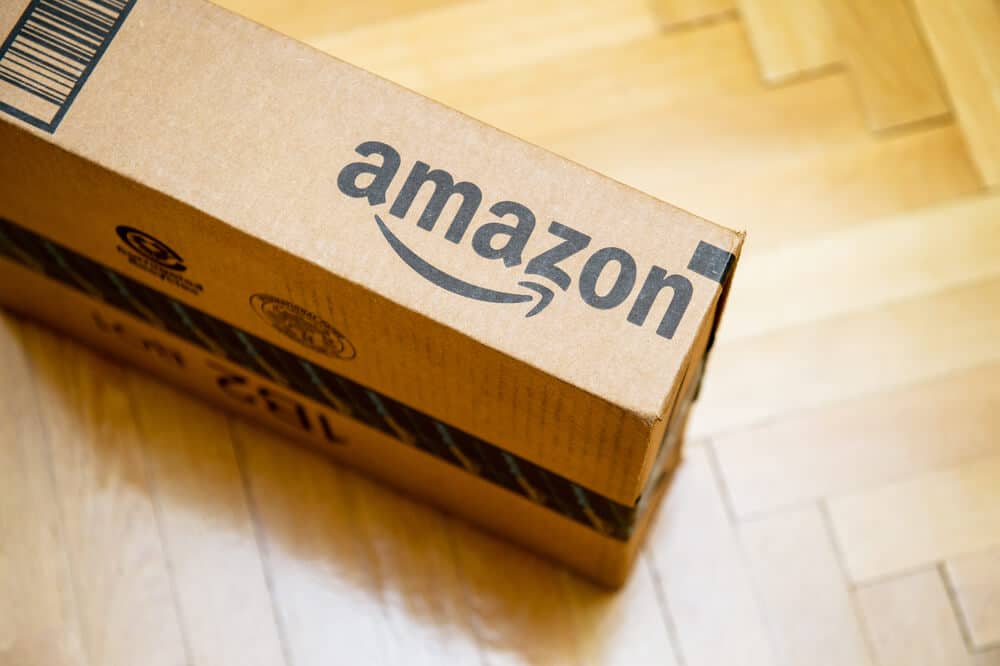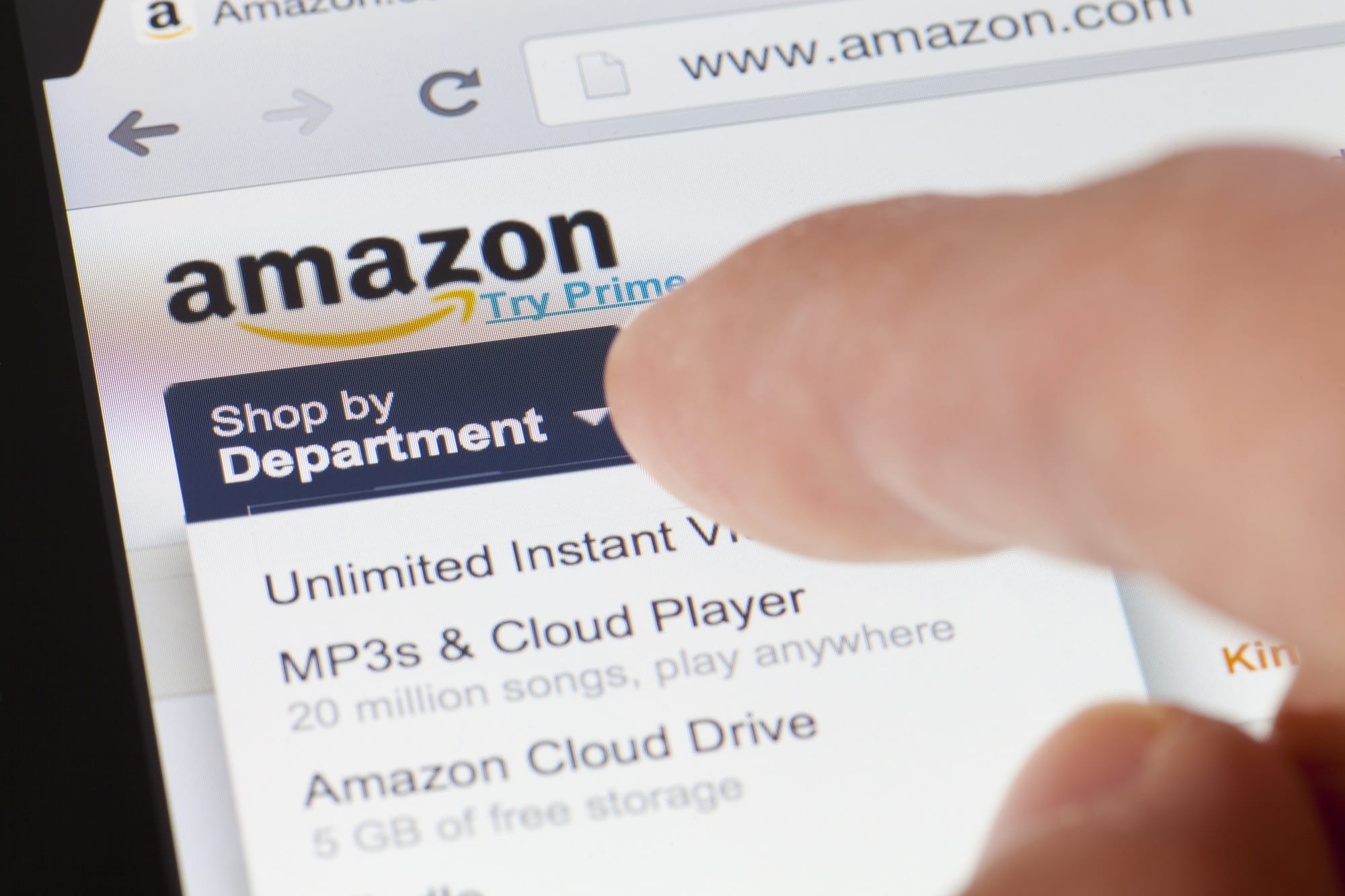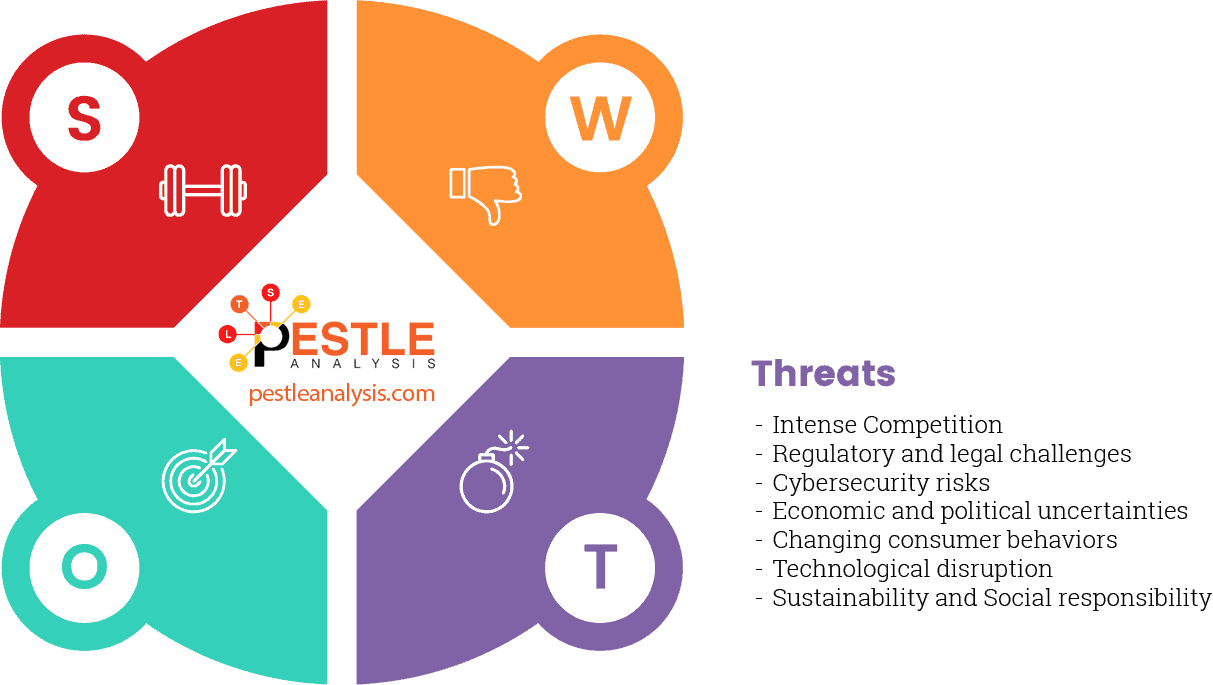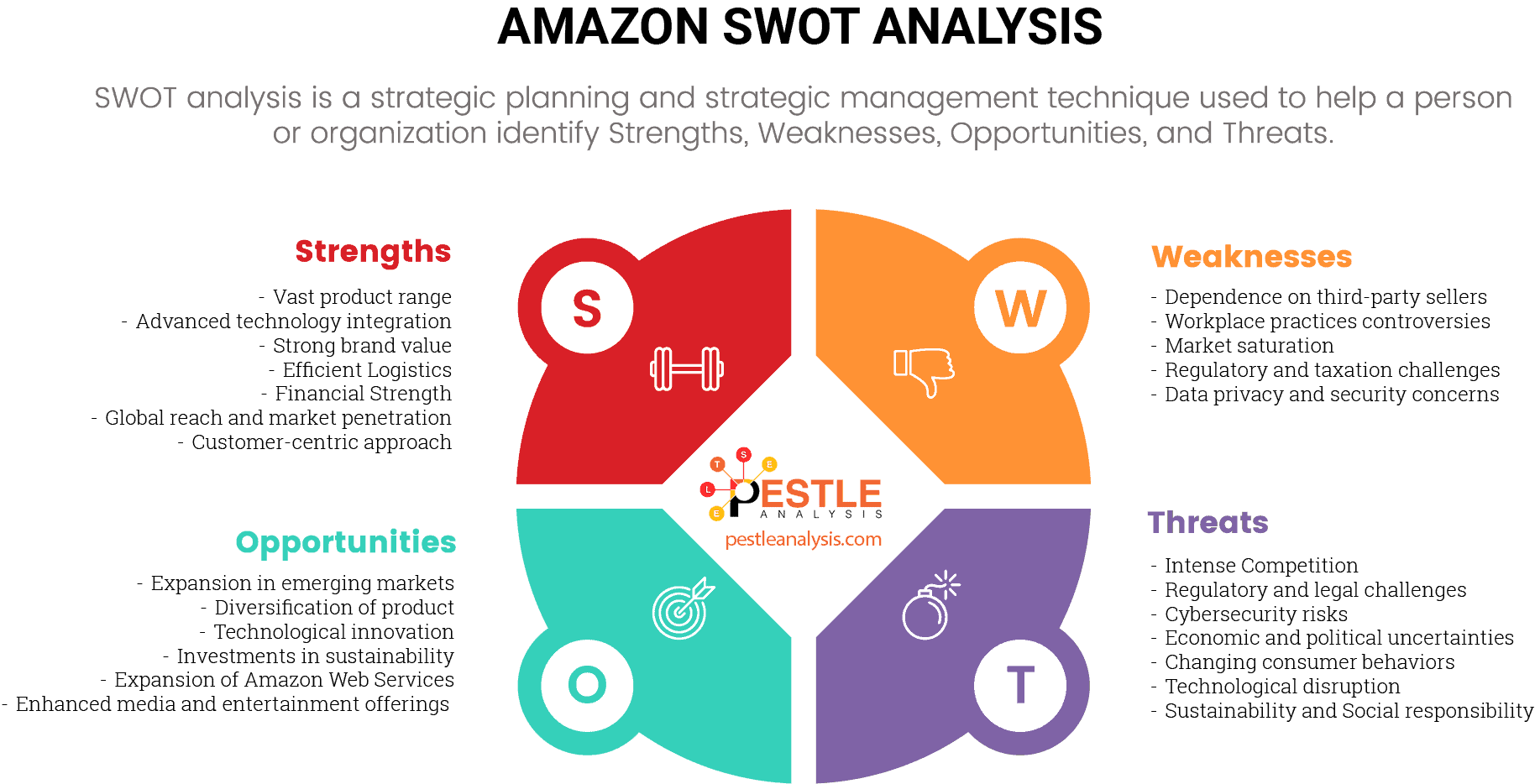Our Amazon SWOT Analysis discusses its strengths, weaknesses, opportunities, and threats, revealing what is unique about Amazon.
Global e-commerce and cloud computing are on the rise. Amazon stands as a colossus, having expanded far beyond its origins as an online bookstore into a technology giant. This Amazon SWOT analysis assesses the external strategic factors (opportunities, and threats) that can propel or hurt Amazon's market dominance. At the same time, we'll focus on the internal factors to spot its strengths and weaknesses.
Through this analysis, we'll have a better view of Amazon's strategic positioning and future outlook. The SWOT will offer insights into how it continues to shape the e-commerce industry and will complement the PESTLE analysis of Amazon we conducted recently.
Today's Amazon SWOT analysis will:
- start with the strengths that form the backbone of Amazon's market leadership
- move to the weaknesses that pose challenges to its operations
- discuss the opportunities that lie ahead in the burgeoning digital economy, and
- reveal the threats from one of the most competitive markets
By examining these influences, we will also explore what is possible in the realms of e-commerce and technology. In the meantime, I've written everything you need to know about SWOT here.
Amazon Strengths

Did you know that the first book Amazon ever sold was Douglas Hofstadter's "Fluid Concepts And Creative Analogies: Computer Models Of The Fundamental Mechanisms Of Thought" in July 1995?
Now you know, as we begin our Amazon SWOT Analysis by finding out the brand’s strengths.
Vast Product Range and Diverse Services
- Broad Selection: Amazon's online marketplace offers millions of products across a wide variety of categories, from books and electronics to groceries and fashion. This extensive selection attracts a diverse customer base with varying needs and preferences, making Amazon a one-stop shop for online shopping.
- Service Diversification: Beyond physical goods, Amazon has successfully ventured into numerous service sectors. Amazon Web Services (AWS) dominates the cloud computing landscape, providing a robust revenue stream. Additionally, Amazon Prime, Prime Video, and Amazon Music enhance customer loyalty through value-added services, while Amazon Fresh and Amazon Go represent its foray into the grocery and retail sectors.
Advanced Technology Integration
- Innovation Leadership: Amazon is at the forefront of integrating advanced technologies like artificial intelligence (AI), and machine learning (ML) into its operations. This focus on technology not only streamlines operations but also creates personalized customer experiences, such as product recommendations and voice shopping via Alexa..
Strong Brand Value
- Global Recognition: Amazon is one of the world's most recognized and trusted brands. Its commitment to customer service, fast shipping, and easy returns has cultivated a loyal customer base that frequently turns to Amazon for their shopping needs.
- Brand Extensions: Amazon has successfully extended its brand into various sectors, including entertainment and smart home devices, further embedding itself into the daily lives of consumers. This brand strength supports cross-selling and new market entries.
Efficient Supply Chain and Logistics
- Logistics Mastery: Amazon's supply chain efficiency is a critical component of its business model, enabling it to offer rapid shipping options such as Same-Day and Two-Day delivery for Prime members. Its global network of fulfillment centers, sortation centers, and delivery stations is optimized for fast and efficient order processing.
- Innovative Delivery Solutions: Amazon continues to innovate in logistics and delivery, experimenting with drone delivery (Prime Air) and advanced robotics in warehouses. These initiatives aim to reduce delivery times and costs, enhancing customer satisfaction and operational efficiency.
Financial Strength
- Robust Revenue Growth: Amazon's diverse business model has facilitated strong revenue growth year over year. Its ability to continuously expand into new markets and product categories, coupled with the profitability of AWS, underscores its financial resilience.
- Investment Capacity: Amazon's financial health allows it to invest heavily in research and development (R&D), infrastructure, and acquisitions to fuel future growth. This investment capacity is crucial for maintaining technological leadership and expanding its market reach.
Global Reach and Market Penetration
- Worldwide Presence: Amazon's e-commerce platform serves customers around the globe, with dedicated websites in over a dozen countries. This global reach enables Amazon to tap into emerging markets, adapting its offerings to local tastes and preferences.
- Localization Strategies: Through localization of product offerings, website language, and customer service, Amazon has successfully penetrated diverse markets, overcoming cultural and regulatory barriers to establish a strong international presence.
Customer-Centric Approach
- Focus on Customer Satisfaction: Amazon's business model is built around customer-centricity, prioritizing customer satisfaction above all. Features like easy navigation, personalized recommendations, comprehensive product information, and customer reviews enhance the shopping experience.
- Loyalty Programs: Amazon Prime is a testament to Amazon's commitment to value-added services, offering benefits such as free shipping, exclusive content, and early access to deals. This program not only increases customer retention but also drives higher average spending among members.
As Amazon leverages these strengths to expand into new markets and sectors, it solidifies its role as a leader in both e-commerce and technology.
Amazon’s market share, stock market performance, top management, strategy, infrastructure, and logistics are its greatest advantages. However, Amazon is not without its struggles.
Next, in our Amazon SWOT analysis, we’ll look into factors holding Amazon’s expansion back.
Amazon Weaknesses

Did you know that in the early days of Amazon, a bell would ring in the office every time someone made a purchase acting as a cause for celebration and a moment of pride for the small team, but as the volume of sales increased, the bell ringing became so frequent that it had to be discontinued?
Now you know, as we continue our Amazon SWOT Analysis by investigating the organization's weaknesses.
Dependence on Third-Party Sellers
- Quality Control Challenges: While Amazon's marketplace is enriched by the diversity and breadth of products offered by third-party sellers, this reliance complicates quality control and consistency. Incidents of counterfeit goods, inconsistent product quality, and fraudulent seller activities have occasionally marred Amazon's reputation and customer trust.
- Profit Margin Pressures: The fees collected from third-party sellers contribute significantly to Amazon's revenue. However, the competitive nature of the marketplace means Amazon must balance between incentivizing sellers and maintaining its own profit margins, which can be a delicate equilibrium to manage.
Workplace Practices Controversies
- Employee Treatment Concerns: Amazon has faced criticism and public scrutiny over its workplace conditions, particularly in fulfillment centers. Allegations of demanding work environments, insufficient breaks, and rigorous productivity expectations contribute to a perception of Amazon as a challenging employer, potentially affecting its brand reputation and employee satisfaction.
- Labor Relations and Unionization Efforts: There have been increasing efforts to unionize Amazon workers, driven by dissatisfaction with working conditions, pay, and the company's response to labor demands. Unionization efforts, especially in the United States and Europe, spotlight the ongoing tensions between Amazon and its workforce, posing potential disruptions to operations.
Market Saturation Challenges
- Growth Sustainability in Core Markets: As Amazon continues to expand, it faces the challenge of sustaining growth in mature markets where e-commerce penetration is already high. This saturation requires Amazon to seek growth through new services or international expansion, which comes with its own set of challenges and uncertainties.
- Intense Competition: In many of its operational sectors, Amazon competes with specialized companies that can focus on niche areas with greater flexibility or expertise. For instance, in cloud computing, AWS faces stiff competition from Microsoft Azure and Google Cloud, while in online retail, companies like eBay, Walmart, and niche e-commerce platforms represent significant competitive pressures.
Regulatory and Taxation Challenges
- Antitrust Scrutiny: Amazon's vast size and market power have attracted attention from regulatory bodies worldwide, concerned with potential antitrust violations. Investigations and regulatory actions could result in significant fines, operational restrictions, or forced divestitures, impacting Amazon's business model and future expansion plans.
- Taxation Issues: Amazon has faced criticism and regulatory scrutiny over its tax practices, including the minimization of tax liabilities in several countries. Changes in international tax laws or increased enforcement actions could increase Amazon's tax burdens, affecting its profitability.
Data Privacy and Security Concerns
- Handling of Customer Data: As a data-centric company, Amazon collects vast amounts of customer information. This raises concerns about privacy, data security, and the potential misuse of personal information. Data breaches or perceived overreach in data usage could erode customer trust and invite regulatory penalties.
- Cybersecurity Threats: Given its reliance on digital infrastructure, Amazon is a prime target for cybersecurity threats, including data breaches, hacking, and other cyber attacks. Despite robust security measures, any significant breach could have far-reaching consequences for customer trust and financial liability.
These weaknesses highlight the challenges Amazon faces in maintaining its market leadership and operational efficiency.
Strengths and weaknesses are internal characteristics affecting Amazon’s performance. Opportunities and threats are external characteristics driving performance.
With a review of internal factors complete, let’s move to the external factors of our Amazon SWOT analysis, starting with opportunities.
Amazon Opportunities

Did you know that Jeff Bezos initially named the company "Cadabra," as in "Abracadabra" and later renamed it Amazon mainly because it starts with the letter 'A,' placing it near the beginning of alphabetical listings?
Now you know, as we explore the marketplace's opportunities in our SWOT Analysis of Amazon.
Global Expansion in Emerging Markets
- Untapped Markets: Despite its global presence, significant growth opportunities exist for Amazon in emerging markets in Africa, Southeast Asia, and Latin America. These regions, with their growing middle-class populations and increasing internet penetration, offer fresh customer bases for Amazon's e-commerce and cloud computing services.
- Local Partnerships and Acquisitions: To navigate the complexities of new markets, including local regulations, consumer preferences, and logistical challenges, Amazon can pursue strategic partnerships and acquisitions. These collaborations can facilitate smoother market entries, enhance local offerings, and expedite customer base growth.

Diversification of Product and Service Offerings
- Healthcare Sector: Amazon has started making inroads into the healthcare industry with Amazon Care and the acquisition of PillPack. Expanding its presence in this sector, especially in telehealth services, pharmaceutical distribution, and health tech solutions, presents a significant growth opportunity.
- Financial Services: Leveraging its vast customer data and platform capabilities, Amazon could expand into financial services, offering payment solutions, insurance, lending, or even banking services. This could open new revenue streams and enhance customer stickiness.
Technological Advancements and Innovation
- Artificial Intelligence (AI) and Machine Learning (ML): Amazon is well-positioned to lead in AI and ML innovations, applying these technologies to improve operational efficiencies, customer personalization, and new product development. Further investment in AI could solidify Amazon's competitive edge in various sectors, including retail, cloud computing, and logistics.
- Autonomous Delivery Systems: Continuing to develop and deploy autonomous delivery technologies, such as drones (Amazon Prime Air) and autonomous vehicles, can reduce delivery times and costs. This not only enhances the customer experience but also sets a new standard in logistics and delivery services.
Investments in Sustainability and Renewable Energy
- Sustainability Initiatives: As consumer awareness and demand for sustainable practices increase, Amazon has the opportunity to lead the way in environmental sustainability. Expanding its commitment to renewable energy, zero-emission delivery methods, and sustainable packaging can improve its public image and comply with regulatory expectations.
- Renewable Energy Projects: Amazon can further invest in renewable energy projects, not only to power its vast network of data centers and fulfillment centers but also as a business venture into the growing renewable energy market.

Expansion of Amazon Web Services (AWS)
- Cloud Computing Growth: AWS can capitalize on the accelerating shift towards digital transformation and cloud computing across industries. Expanding its services to cater to specific industry needs, such as government, healthcare, and finance, can drive further growth.
- Edge Computing and IoT: AWS has the opportunity to lead in edge computing and the Internet of Things (IoT), providing solutions that process data closer to where it is generated. This can open new markets and applications in smart cities, automotive, manufacturing, and more.
Enhanced Media and Entertainment Offerings
- Content Creation and Distribution: Amazon Prime Video and Amazon Music have established Amazon as a player in the media and entertainment industry. Investing in original content creation, acquiring content libraries, and forming strategic partnerships can enhance Amazon's competitive position against other streaming services.
By strategically investing in these areas, Amazon can not only mitigate its existing weaknesses but also build on its strengths to maintain its leadership position in the global market.
Every new endeavor Amazon enters, the world expects greatness. But can Amazon “deliver”? Let’s evaluate some of the threats Amazon faces next in our Amazon SWOT analysis.
Amazon Threats

Did you know that desks at Amazon, famously known as "door desks," were originally made from wooden doors and 4x4s to save costs, as a practice of one of Amazon's leadership principles, "Frugality?"
Now you know, as we’re finalizing our SWOT Analysis of Amazon by exploring Amazon's greatest external threats.
Intense Competition
- E-Commerce and Retail: Amazon faces fierce competition from both traditional retailers moving online and from established e-commerce platforms. Companies like Walmart, Alibaba, and niche online retailers are continuously improving their online presence, customer experience, and logistics capabilities to compete directly with Amazon.
- Technology and Cloud Services: In the cloud computing sector, AWS competes with strong players like Microsoft Azure and Google Cloud. These competitors are aggressively expanding their services and capabilities, potentially eroding AWS's market share.
Regulatory and Legal Challenges
- Antitrust Regulations: Amazon's size and influence have attracted increased scrutiny from regulators in the United States, European Union, and other jurisdictions. The company faces the threat of antitrust investigations that could lead to regulatory actions, including fines, restrictions on its business practices, or even the forced divestiture of parts of its business.
- Data Privacy and Security Laws: With stringent data protection regulations like GDPR in Europe and similar laws in other regions, Amazon must navigate complex legal landscapes. Compliance challenges and the potential for hefty fines pose significant risks to its operations and financial health.
Cybersecurity Risks
- Data Breaches and Cyber Attacks: As a digital-first company, Amazon is inherently exposed to cybersecurity threats. Data breaches can result in the loss of customer trust, significant financial liabilities, and reputational damage. Ensuring the security of its data and systems against increasingly sophisticated cyber attacks is a constant challenge.
Global Economic and Political Uncertainties
- Economic Fluctuations: Amazon's global operations expose it to the risk of economic downturns in key markets. Recessions or economic instability can affect consumer spending patterns, potentially reducing demand for Amazon's products and services.
- Trade Tensions and Tariffs: Political tensions and trade disputes between countries can impact Amazon's supply chain and cost structures. Tariffs and trade barriers may increase costs or disrupt the global flow of goods, affecting Amazon's inventory and pricing strategies.
Changing Consumer Behaviors
- Shifts in Shopping Habits: The rapid evolution of consumer preferences and shopping habits requires Amazon to continuously adapt. The rise of conscious consumerism, for example, demands more sustainable practices and products, while the desire for unique and authentic shopping experiences challenges Amazon's standardized approach.
Technological Disruption
- Innovation by Competitors: The pace of technological innovation means that Amazon must constantly evolve to stay ahead. Competitors may develop disruptive technologies or business models that undermine Amazon's advantages in e-commerce, logistics, or cloud computing.
Sustainability and Social Responsibility Expectations
- Environmental Impact: Amazon's large-scale operations, particularly its logistics and data center activities, have a significant environmental footprint. Increasing public and regulatory expectations for corporate sustainability practices require Amazon to invest in green technologies and sustainable operations.
- Social Responsibility: As Amazon's influence grows, so does the expectation for it to address social issues, including labor practices, community engagement, and economic inequality. Failure to meet these expectations can lead to public backlash and impact its brand reputation.
By addressing these threats head-on, Amazon can continue to build on its strengths, seize opportunities, and maintain its position as a leader in the global marketplace.
Recommendations based on the Amazon SWOT Analysis

Let's briefly see a few recommendations for the multinational technology company, following on our Amazon SWOT Analysis. These focus on reinforcing its market position and addressing key challenges to ensure sustainable growth.
- Market Dominance: Strengthening market leadership through intensified marketing, promotions, and leveraging competitive advantages.
- Global Controversies: Addressing and resolving issues related to taxes and app features to mitigate negative publicity and enhance its global reputation.
- Physical Stores Expansion: Broadening its market reach and brand visibility by establishing physical stores outside the U.S., enriching customer experience and accessibility.
- Focus on Developing Countries: Capitalizing on growth opportunities in developing nations to secure a strategic foothold and expand its market base.
- Competitive Edge: Further distancing itself from competitors by enhancing its competitive advantages, ensuring it remains a market leader.
- Counterfeit and Cybercrime: Upgrading technological measures to combat counterfeit sales and cybercrimes, safeguarding its platform and user trust.
- Network Security: Strengthening network security systems to protect consumer rights and enhance trust in Amazon's ecosystem.
Wrapping up our SWOT Analysis of Amazon, it's quite possible I've missed a few things. If you believe we've missed a critical aspect of Amazon's SWOT, or if you have insights that could enrich the discussion, I invite you to share your remarks with us.
In the meantime, you may check out analysis we've conducted before on Amazon's main competitors. This will help you understand better Amazon's market:
- SWOT Analysis of eBay
- SWOT Analysis of Walmart
- SWOT Analysis of Alibaba
- SWOT Analysis of Best Buy
- SWOT Analysis of Target

